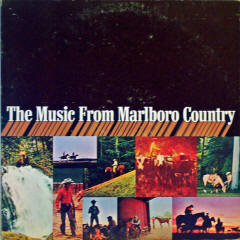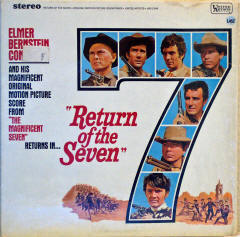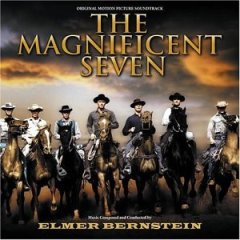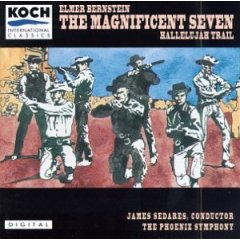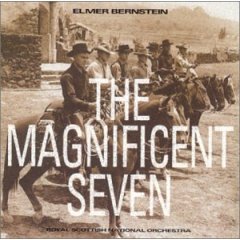|
You are reading the older HTML site
Positive Feedback
ISSUE
26
The Magnificent Seven
Most film music is forgettable. You watch the film and don't really notice the background music. Good film scores, on the other hand you do notice because they really enhance the movie watching experience. Great film scores you not only notice, but they take on a life outside of the movie. How many times have you heard the Star Wars theme on the radio or on TV totally divorced from the movie itself? Like the Star Wars music, most people have also heard the theme from The Magnificent Seven. However, they usually don't know that they are listening to music that originally came from a film. If they can place the music at all, they remember it as the music from the Marlboro Country cigarette commercials. If you are too young to remember the Marlboro cigarette commercials, you can get a sample of the music here: http://www.amazon.com The Magnificent Seven came out in 1960. The critics complained the movie was just Akira Kurosawa's Seven Samurai (1954) transposed from Japan to the Old West. That may be true. However, more people watched and enjoyed The Magnificent Seven than ever watch the Seven Samurai. Being a Kurosawa, fan I have seen the Seven Samurai many times, but that does not stop me from enjoying The Magnificent Seven. They are both great movies in their genre.
The Magnificent Seven was released by United Artists. At that time they were one of the smaller film companies―in fact they did not even own a studio. Thus, United Artists was not set up to capitalize on the value of their soundtrack library. No soundtrack LP of The Magnificent Seven was ever issued. Even worse, the master tapes of the soundtrack recording sessions were not stored properly and suffered significant damage before they were rescued twenty three years later. Worse still, the original orchestral scores used at the recording sessions were destroyed. Fortunately for music lovers, Hollywood loves sequels. In 1966, Return of the Seven was released using essentially the same film score. This time a soundtrack LP was issued (UAS 5148 12 cues, 30:47 minutes). However, again the master tapes and the orchestral scores were apparently lost. The music, however, thanks to the Marlboro commercials, was now famous. For music lovers, you had a choice of either buying the soundtrack LP to Return of the Seven or one of the many re-recordings on LP of portions of the music.
In 1960, Elmer Bernstein, the composer of The Magnificent Seven, was a young and upcoming film score composer with credits such as The Man with the Gold Arm and the Ten Commandments to his credit. By the 1980s, Elmer Bernstein was now a famous film score composer. With the film studios reissuing their libraries in the new digital format, plans were made to issue The Magnificent Seven on CD (Varese Sarabande 302 066 559 2). The original master tapes were found and restored. The CD made from the restored master tapes included 23 cues (67:34 minutes), arranged in the order they appeared in the film. While not a great sounding CD from a sonic standpoint, at least the music was available.
Over the next decade the popularity of the music continued. A rerecording of the music with improved sonics was deemed necessary. In the early 1990s, Christopher Palmer obtained from Elmer Bernstein the original detailed sketches of the film score. From these, Christopher Palmer produced an orchestral score comprising 15 sections that included by his estimate 92-95% of the original music. The sections were arranged in an order that made musical sense rather than following the order of the movie scenes. This new orchestral score was recorded in 1993 on the Koch International label (3-7222-2) by James Sedares and the Phoenix Symphony Orchestra (57:31 minutes). In 1994, Elmer Bernstein issued a statement that said "I never really enjoy listening to other conductors' performances of my work." The first recording of the entire score of The Magnificent Seven is a most happy exception. Maestro Sedares and the Phoenix Symphony have performed the music with tremendous artistry, energy and joy, which makes this recording the definitive interpretation in my opinion.” That having been said, four years later Elmer Bernstein conducted the Royal Scottish National Orchestra in another recording of Christopher Palmer's orchestration for BMG/RCA (09026-63240-2 56:32 minutes). So, as it stands currently, you have one LP and three CD versions that represent the official versions of the music from The Magnificent Seven. Which should you own, assuming you aren't a fanatic and don't already own all four versions? The strengths of the LP are that it is conducted by Elmer Bernstein and that it is the best sounding of the four versions. The LP is a little shy on the bass, but otherwise it is an excellent orchestral recording with a wide and deep soundstage, very detailed and dynamic. The drawbacks to the LP are that it contains only half of the music that is found on the CDs. Also, the LP is hard to find in near mint or better condition. Amongst the three CDs, the original 23 cue soundtrack has the worst sonics. The music is flat and two dimensional. It is not very dynamic and seems a little veiled. On the other hand, it does contain 3-4 minutes of music that are not found on the other two CDs. If you are a completist, then you need this CD. If you want only one CD, then I would pass on this one. The choice between the remaining two CDs is difficult. Both CDs contain the same music. However, performance-wise and sonically, the two recordings are very different. The BMG/RCA recording is distantly mic'ed in a large, vacant hall. There is a lot of reverb. To my ears this is a strange acoustic. It is not unnatural, but it takes some getting used to. The Koch recording is a standard orchestral recording with the recording perspective about row twelve. There is just enough reverb to give an authentic hall feeling. Both recordings are about equal on detail, clarity, and dynamics. Sonically, I prefer the Koch over the BMG/RCA because of the BMG/RCAs distant recording position. I find this preference strange because my symphony season tickets are in the upper balcony. Performance-wise I have to give the nod to the RCA/BMG. It may be because I have been listening for the last forty years to Bernstein conducting the music in both the films (which I have seen countless times) and on the LP which I bought in the 1960s and have played many times. The Sedares interpretation is a fine symphonic performance. Listening to it, I find it very enjoyable. However, I find that Sedares' interpretation is not true to the film; i.e. the music does not match the image I have in my mind of the particular scene in which the music was used. If I had never seen the movies I would say that the Sedares interpretation is smoother and more lyrical. It sounds like a symphony. The music is a cohesive whole. The Bernstein interpretation, however, is choppy. It has accents and dynamic peaks that don't make musical sense unless you have seen the movies. My preference is, obviously, with the RCA/BMG. However, if you are not familiar with the movies and listen to a lot of classical music my guess is that you will prefer the Koch. The Koch also has the advantage of being cheaper. You can buy them used off of Amazon.com for around $5. The RCA/BMG, which is also out-of-print, is more difficult to find and usually costs $15-$30. Whichever version you buy, I am sure you will be happy listening to one of the all-time great film scores.
|

